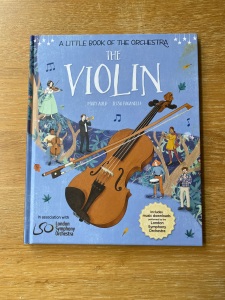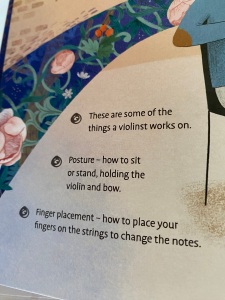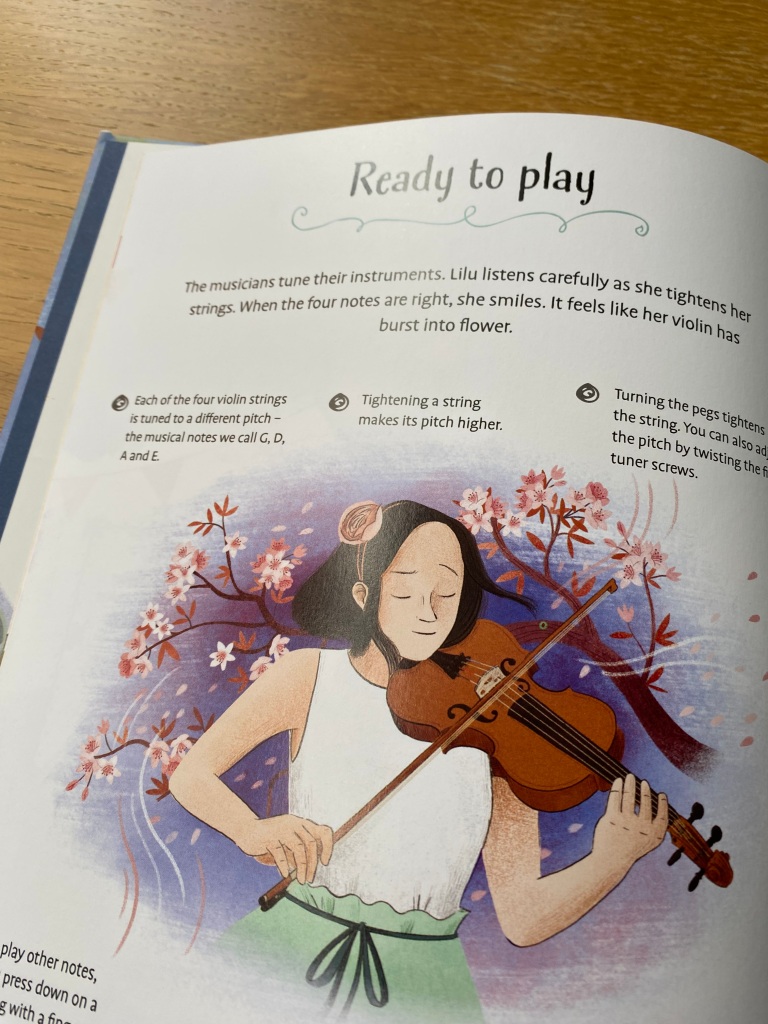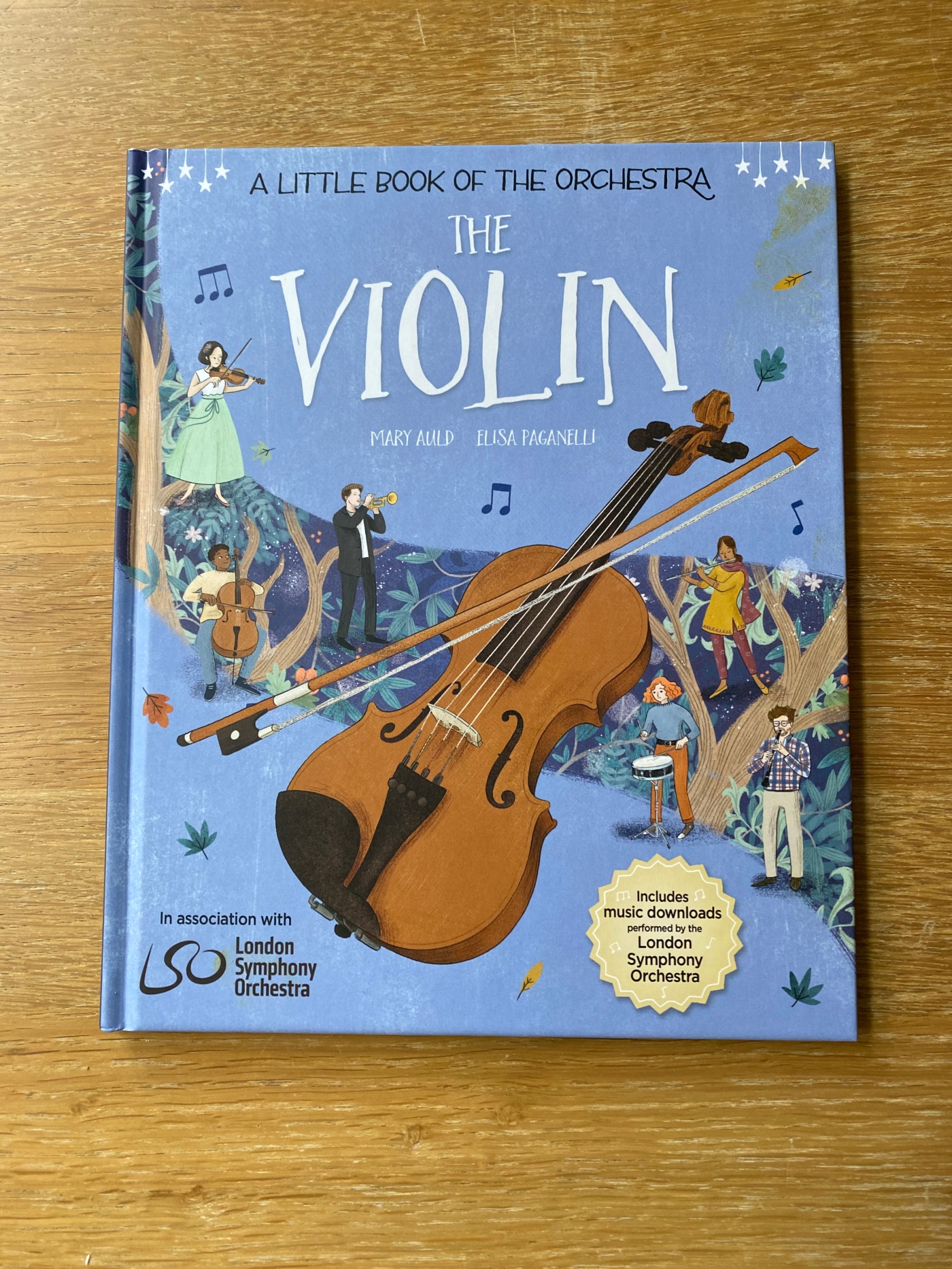My little girl is starting her first lessons learning to play an orchestral instrument. Her instrument is the violin and she has been so very excited to start to learn to play it! So for her most recent birthday I bought her this book – A Little Book Of The Orchestra – The Violin by Mary Auld and Elisa Paganelli.

Blurb from the back of the book:
Luli loves playing the violin in an orchestra. She is so excited when she hears that her orchestra will play outdoors in Trafalgar Square. It’s a midsummer concert for everyone!
A LITTLE BOOK OF THE ORCHESTRA reveals the world of a large orchestra in a story of one of its musicians and their instrument. In this book, find out about the violin and what it is like to learn and play. As you read, you can listen to the amazing music the violin creates both on its own and within the orchestra.

What is this story about?
As the blurb suggests this is a book about Lilu, a violinist who plays in an orchestra. The story that runs through the book starts with Lily playing at her friend’s wedding both with a solo performance and with a string quartet during the reception. It follows her as she starts rehearsals for a special midsummer concert with the whole orchestra which is due to take place in London’s Trafalgar Square; as she helps student players who join the orchestra for the performance; and for the performance itself. The story helps to let the reader know a little bit about what it is like to be a musician who also plays professionally in an orchestra, for example she talks a bit in the story about how it can be harder to be heard when performing outside. It also talks a little bit about the other things that go into putting on a show, like a big outdoor performance. The book introduces us to the Stage Manager who talks a bit about what she has to think through in order to put on a great show and look after the musicians and their instruments and how she has to consider things like the weather – both lots of rain and lots of sun may not be great for musicians and their instruments! I really like that this book includes this aspect of show running, that there is a lot involved in putting on any kind of show than the performances on stage – but that might just be the former House Manager in me talking, maybe.
In addition to the story that threads through the whole of the book, you will find information about different string instruments, especially the violin. For example one page shows you a violin and what each part of the instrument is called; another page gives you information about how to make a sound with the violin; yet another page talks about the orchestra, where different musicians will sit depending on what instrument they play, and even about the role of the conductor of an orchestra. Throughout the book, this information (with the exception of the page labelling the different parts of the violin) is on the page next to a hand drawn bullet point. So you can easily see where the more factual information is by looking for these bullet points.
In a book about a musical instrument, you might expect to hear some music, maybe? This book will not disappoint you with that. There are listening suggestions on almost every page – these listening suggestions reflect the music being discussed on that page, and have been specially recorded by musicians of the London Symphony Orchestra. At the front of the book there is a weblink given where you can access the listening suggestions and listen along while you read the book. The music is well worth a listen anyway, and brings the book to life. I should say here that the listening suggestions appear in a framed box so you can clearly see what the author is suggesting you listen to.
I mention the framed box in the paragraph above, and the bullet points next to the more factual information because they really help you with reading the book, especially with younger readers. They help you understand what information is presented there – if you just want to read the story, ignore all of the other information given. If you want to learn more about the violin itself, look for the bullet points, if you are wondering what to listen to right now, just glance in the framed box. The book is very well laid out, and helps the reader understand what they are reading.


At the end of the book you will find more information about the listening tracks and a very handy glossary explaining the musical terms used through the book. And finally at the very start of the book you will find two short forewords. One is written by Harriet Rayfield, First Violin of the London Symphony Orchestra, who the book was written in conjunction with – guess which orchestra the book is based on – in which she talks about how she got the bug for music making, as she describes it. And the second foreword is from the London Symphony Orchestra’s Music Director, Conductor Sir Simon Rattle – in which he talks a little about the series of A Little Book Of The Orchestra books, the work of the London Symphony Orchestra (LSO) and its goal of bringing the music the LSO makes to all parts of society, including people who wouldn’t otherwise be able to engage with them. The LSO has a thriving community and education programme which aims to show everyone in the community, both local and further afield, the LSO’s passion for their music, and music-making in general.
I will end this section by talking a little about the illustrations in the book. In books for children, especially for young children, pictures are so very important. Younger readers get distracted very easily, their levels of concentration are still developing and they get as much, if not more (depending on their age) information from a book through the illustrations. The pictures capture their imaginations and engage them and keep them wanting to look at the book. When my children were very young I would regularly see them reading a book. They were too young to yet understand the words on the page, but they knew exactly what was going on in the story by looking at the pictures. If it was a book we had read several times before (and there were many books we read so often that we could all recite them, looking at you Gruffalo!) then they needed to just look at the pictures and it would prompt them to recall the whole of the book. The illustrations here are lovely. Especially where the author recounts the story of A Midsummer Night’s Dream by Composer Felix Mendelssohn – the music being prepared for the midsummer concert in Trafalgar Square. You can see for yourself how lovely the illustrations are below:




Who is this book for?
I bought this book for my daughter’s 7th birthday as she is starting to learn to play the violin, and I think it is pitched just right for her age and a little older. There is quite a bit of factual information given in the book to satisfy their developing brains, a good amount of story and plenty of illustrations to capture their imaginations. But the book is written in simple enough language for younger readers to understand and be able to read independently, or with a caregiver. I note that Amazon recommend the book for 7-9 year olds, and I would agree with this suggestion. You know your children best, and the books they are interested in or that they would feel were too complicated or too simple for them, but I do think that 7-9 is a good age recommendation for this book.
Where to buy the book
I bought this book from Waterstones for the RRP of £12.99 as it was a gift for my daughter’s birthday. It is available from other retailers of course, as are further books in this series about The Cello, Drums and Percussion, The Flute and The Trumpet. Maybe there may be more in the future?
At the time of writing this review, the book is available on Amazon priced at £11.96, but do bear in mind that prices on Amazon can fluctuate depending on demand.
Would I recommend this book?
Yes. Yes I would. I think it’s lovely. The music you can listen to as you read the book is fantastic, and a great introduction to the work of the London Symphony Orchestra. I think it gets the balance of story and factual information just right for younger readers. I think it’s lovely.
If you have enjoyed reading my blog post, thank you. I am always looking for ideas for the blog, so would love to hear from you with suggestions for topics you would like me to cover in the future. Also, if you would be interested in supporting me to keep this blog running, buying the books to review here, and supplies to make the DIY instruments, for example, I would be absolutely delighted if you would consider buying me a coffee using the following link: Buy Me A Coffee Thank you!!
